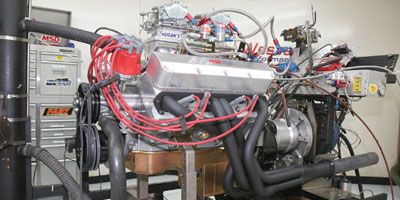
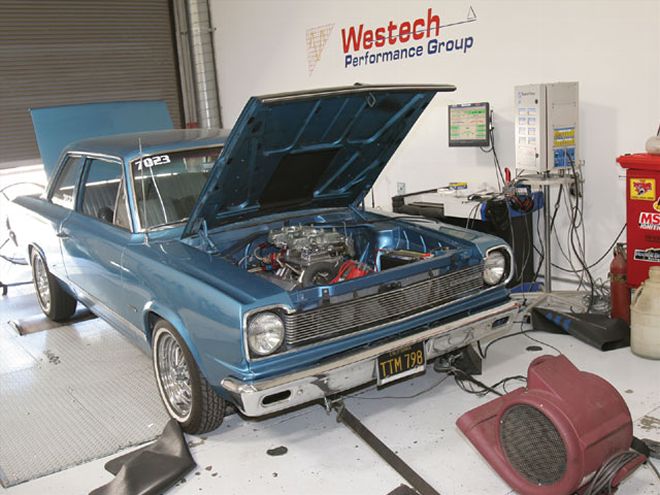
'We were crowded around the window of glass and chicken wire designed to separate us from flaming chunks of engine shrapnel when Westech's Steve Brul's hand crept toward the little red button on the console. With his left arm pumping the throttle lever, he touched the button, making the engine bark and twist hard to the left as the nitrous system was purged. On the way past 4,000 rpm, the solenoids were clicked open and the engine tried to leap off of the cradle, sounding a little too angry for just a 150-shot. When the engine settled back to an idle, it looked like the balancer was still attached and nothing was sticking out of the oil pan as the Superflow quietly downloaded the info from the cell. It was a unibody-bending 695 hp on our big tune-up.
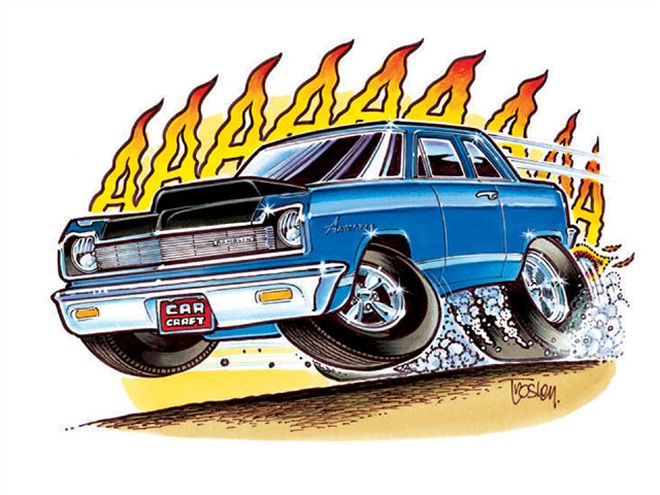
'CC/Rambler
If you haven't seen this engine before, we have been using it and the '67 Rambler American it belongs to for dragstrip testing and a few runs to Vegas and San Diego to prove its mettle as a real-world street/strip car. The engine was pulled from a wrecked '85 Jeep Grand Cherokee and assembled almost two years ago by JMS Racing Engines in Monrovia, California. The only trick part about it is a mild stroke on the rod journals to fit a set of Scat 6-inch Chevy rods and custom Lunati pistons. The rest is off-the-shelf parts from Edelbrock and Holley. In various states of tune, it's made from 425 to 480 hp and propelled the Rambler to a best uncorrected time of 12.06 at 112.28. Check out the complete specs in the engine sidebar.
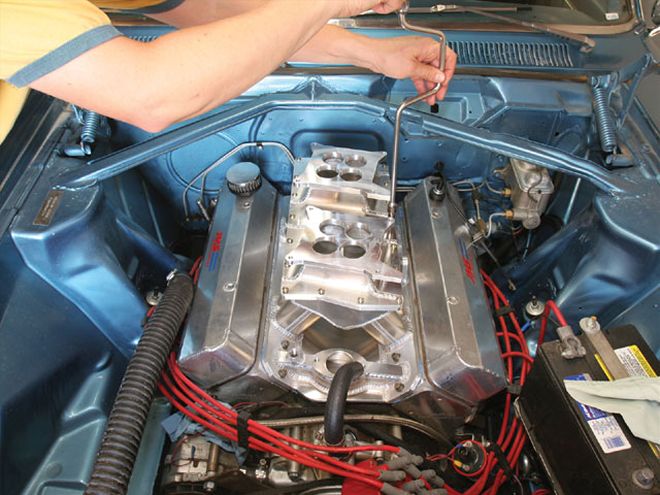
Since there aren't too many people asking for AMC manifolds, we had to ship Tim Hogan our Performer RPM manifold for a template and give him our complete engine specs. It bolted on with no problem, although we were stumped by the use of a Chevy water neck mount.
The car is fast, but we wanted more . . . a lot more. So instead of building a whole new engine or pumping the compression and cam to unstreetable levels (we'll do that later), we decided to go for the glory of a tunnel-ram and the juice in a bottle in a big way. Now it can be driven every day and fry tire at the track on the weekends, just like a street machine should.
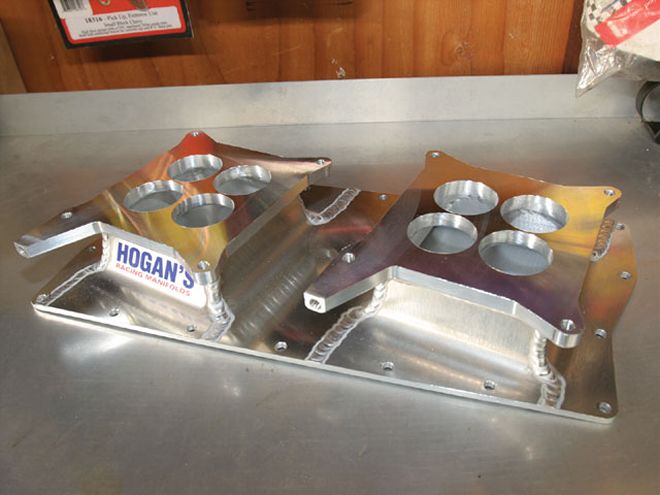
The tunnel-ram has two parts. The upper half is designed to distance the carb from the runners to enhance the low-rpm signal without increasing the size of the plenum. Since our engine is not too radical by Hogan's standards, the plenum is relatively small. Larger plenums will stagnate the air, requiring a lot of rpm to get it moving. If we decide to add a solid roller and a steel crank to the AMC and rev it, we can add plenum volume with a spacer plate.
The Baseline
465 hp at 6,100
431 lb-ft at 5,200
About a month before we went to press on this issue, the distributor and cam gears bumped heads, forcing a complete rebuild of the engine to clear out the metal shavings that flowed into the oil. After readers screamed for a rebuild, we used an Edelbrock Torker manifold with a Holley 750 HP carb and a set of off-the-shelf Edelbrock heads. We also slipped in a Voodoo hydraulic flat-tappet cam with 254/258 degrees at 0.050 and 0.555-inch lift and a matched set of cam and distributor gears from Bulltear Industries. It's as close to the original combo as we could get.
The Manifold
474 hp at 6,200
440 lb-ft at 5,100
The tunnel-ram is the ultimate head-turner for the street-machine guy. In terms of average torque, horsepower, and screaming power at the top, there is no beating it. We scoured the Internet for an Edelbrock AMC UR-18 tunnel-ram and found that they have become vintage collector's items and therefore crazy expensive. For you Chevy, Ford, and Mopar guys, there are a million tunnel-rams in catalogs, at swap meets, and on the Internet ripe for the choosin'. We had the ram made at Hogan's Racing Manifolds for the purposes of this test. The upside to a custom manifold is that it can be made specifically to suit your particular engine needs.
The idea behind the ram is simple: Increase torque by increasing the length of the intake runner and therefore the virtual length of the intake port on the cylinder head, creating a column of air that fills the cylinder when the intake valve is popped open. In theory, this should shove more air into the cylinder.
On the engine dyno, all of our pulls were from 4,000 rpm to redline, because that's where tunnel-ram power lives. The ram beat the single-plane Torker manifold and 750 carb by about 10 hp at the top, boosting the torque peak from 431 to 440 lb-ft and adding an average of 9 lb-ft of torque and 8 hp average from 4,000 to the power peak. Plugging that info into the Comp Cams DeskTop Dyno just sneaks the Rambler into the high 11s. The program has been within 0.10 or so against actual track times, so we tend to believe it.
The Carbs
We've been told that a pair of vacuum-secondary carbs on a tunnel-ram rarely open all the way on the street. We've also heard that this phenomenon is a good thing, because the engine will only use as much air and fuel as it needs. If you can tune the carbs for a smooth transition, a set of small vacuum-secondary carbs is perfect for a mild street machine. To test this theory, we installed a pair of 525-cfm vacuum-secondary Road Demons and strapped the Rambler to the chassis dyno. On the first pass there was a noticeable bog before full throttle as the secondaries snapped open against the secondary spring. After we installed a heavier spring and dropped the secondary jets to 72 to slightly lean out the fuel curve, the Rambler made 365 rwhp. Just to see what it would do, we then tied the secondaries open and ran it again. After a huge lean dip caused by the lack of a secondary accelerator pump, the Rambler made 390 rwhp, a gain of 25 hp. That's when we added a set of 650-cfm Race Demon carbs that were set up specifically for a tunnel-ram application. Using out-of-the-box jetting, the 650s made a peak of 391 hp with a noticeable improvement in the throttle response on the dyno.
Out on the street, the 525s felt a little crisper at low rpm but would bog slightly when the throttle was whacked open. The 650s were the opposite, as they sagged a bit at traffic lights and absolutely obliterated the tires when we went WOT.
We asked Steve Brul for some dirt. He's seen vacuum-secondary carbs mounted side by side on tunnel-rams lean out one bank of cylinders at full throttle. His reasoning was that the secondaries were only partially open or not open at all, starving the right bank of cylinders (as seen from the front) and causing the im-balance. And that was the situation here. For an everyday street machine guy who just cruises and blips the throttle once in a while, this likely won't make a difference. On a drag car that sits at full throttle, a lean condition can hurt it. For our nitrous application, it was out of the question.
The Kit
Now the fun begins. We've heard for years that the tunnel-ram trades bottom-end driveability and power for a good peak number. We say, so will a giant cam. To fix both problems, we bolted on the Nitrous Oxide Systems (NOS) Pro Fogger Kit. For absolute, stupid fun, you can't beat the Fogger. We briefly considered a pair of plates but discovered the extra inch the plates provided under the carburetor smashed the air cleaners into the top of the hoodscoop. Since we wanted to drive the car on the street with a hood, we opted for the low-profile, high-visibility charms of the system with the crazy plumbing.
NOS offers so many different complete systems that they've seemed to run out of names for them. What is important is the delivery system and the size of the solenoids. The Powershot and Cheater solenoids are for wet and dry systems and for simple plates that can deliver up to 250 hp. The largest fuel solenoid is the Cheater, but there are three more nitrous solenoids if you really want to get crazy. The Pro Shot, the Pro Race, and the Super Bigshot solenoids can be used to create up to 600 hp in a single stage, and by that they mean all at once.
The difference between a plate system and a port system like the Pro Fogger is the method of delivery. The plates simply bolt to the intake manifold directly below the carburetor, and the port system requires holes to be drilled in the intake runner directly above the intake port.
Since hood clearance and horsepower greed led us to use a fogger-style port system, we had to choose between the Sportsman Fogger and the Pro Shot Fogger. The primary difference between the two is the size of the solenoids and ultimately the amount of power the system is capable of delivering. The Sportsman uses Powershot solenoids and can deliver from 50 to 250 hp. The Pro Shot uses a Super Pro Shot nitrous solenoid and a Cheater fuel solenoid for 150-500 hp. You can also combine a fogger with a plate for a two-stage system, where a smaller first stage can be activated off the line to maintain traction; then the plate system will arm somewhere down the track to maximize midrange and top-end speed. Since we will be using a timing system to ease the nitrous on as traction permits, we decided to try the big Pro Shot in a single-stage arrangement. Oh, and we like the idea of an extra 500 hp too.
Little Hit
649 hp at 5,200
638 lb-ft at 5,500
Nitrous doesn't provide a torque curve. It's true. Unlike other power adders, the heroism of nitrous is that you get the torque peak and the horsepower peak right after you hit the button. According to Mike Thermos, owner of Nitrous Supply, peak cylinder pressure usually occurs about 15 degrees ATDC using gasoline. When you add an oxidizer like nitrous, the increased speed of the fuel burn puts peak cylinder pressure earlier in the power stroke, sometimes too early, causing detonation. That's where the rule of thumb that says to retard the timing 2 degrees for every 50 hp worth of nitrous comes from. It puts the pressure peak back where it belongs.
For all the nitrous runs, we used the Race Demon 650TR carbs jetted with 71 primaries and 72 secondaries, dialed back the timing to 28 degrees total, and used NGK R5671A-8 51/48 long-reach plugs, the coldest range available from that brand. The Pro Fogger uses two jets for each nozzle, so there are a total of 16 jets in one system. With #22 nitrous and #24 fuel jets, Brul hit the button at a conservative 4,500 rpm to make the number. He says that you can initiate a 175-shot as low as 3,000 rpm as long as you are at full throttle.
Big Hit
695 hp at 6,100
667 lb-ft at 5,300
That's closing on 700 hp from 370 inches with a cast crank. Nitrous is sick. At this level, we were creeping up on some safety issues. Our personal experience says that you can run up 175 hp with hypereutectic pistons if you use premium gas and a knock sensor to retard the timing. Brul uses what is called the brake mean effective pressure (BMEP) to eyeball the point where pump fuel is going to break down and race fuel is required. BMEP is a dyno calculation that multiplies torque times 150.8 divided by cubic inches, and the magic number that Brul has discovered through years of dyno testing is 225. If you go beyond that, you need to use race gas. For the record, we spiked at 271.
With a tank full of Rockett Brand 114-octane racing fuel, the same plugs, and a total of 28 degrees of advance, we hit the button again. For nitrous runs over 200 hp, Brul likes to hit the button at 4,000 rpm at WOT, right where the tunnel-ram starts making power. We installed #25 nitrous and #28 fuel and jetted the secondary side of the 650TRs to 78. This might seem like a lot of extra fuel, but we wanted to be safe. Since we are not gaining horsepower with a bunch of rpm, the only way to break stuff is by detonating or leaning out the mixture and turning the tops of the pistons into molten aluminum. Both Brul and Thermos think the safety margin is between 10.5 and 11.5 A/F ratio. At the very top, we even dipped into the upper 9s. This is on the too-fat side, but again, we were using a cast crank and detonation would snap it for sure.
After the pull, we had some choices to make. Should we try for the 700hp number? The temptation, especially on the dyno, is to take away a little bit of fuel jet and bring the A/F ratio into the 10s at the top. This would likely find the lost 5 hp but would also be risky. Instead, we should have added perhaps one jet to both the nitrous and the fuel jets and stepped the entire curve up. In reality, the big hit is something that is suited for race gas and a car with a 'cage since it will likely be deep in the 10s at the dragstrip. The 175 shot will be plenty for a pump-gas test-and-tune or a cruise to the local digs, so we left it there.
Safety
Somewhere out there, a traffic safety school instructor is frothing at the mouth. For his piece of mind, we offer some safety tips.
Consider a separate fuel system with a pressure-operated kill switch when you are running the 500hp hurricane the Pro Shot was designed for. If you lose fuel pressure at the top end, the nitrous solenoids will click off and likely save you a lot of cash.
Make sure your charging system is in proper working order. Don't skimp on the alternator and battery; get the good stuff because the solenoids become erratic when system voltage is low.
Run it fat like we did and you won't melt anything. If you pull a plug and see a little pepper on the porcelain, you are lean or detonating, and you are going to break parts. And finally, always use nitrous at an approved racing venue in an appropriate manner. We always do
Mega Power
Test 1 used an Edelbrock Torker single-plane manifold, a Holley 750 HP carb, a Lunati flat-tappet hydraulic cam, and , and 171/48-inch Hooker Super Comp headers
Test 2 consisted of the 370-inch AMC mill with two Race Demon 650TRs and the Hogan's manifold. Jetting was 71 in the primaries and 72 in the secondaries.
For Test 3 we added a shot of nitrous oxide with 22/24 nitrous/fuel jetting with 28 degrees of timing.
For Test 4 we added a bigger shot of nitrous with 25/28 nitrous/fuel and the same timing.
TEST 1 TEST 2 TEST 3 TEST 4 RPM TQ HP TQ HP TQ HP TQ HP 4,000 413 316 425 324 420 320 421 320 4,100 414 323 425 332 420 328 419 327 4,200 414 331 426 341 421 337 419 335 4,300 418 342 428 351 423 347 421 345 4,400 420 352 433 363 426 357 425 356 4,500 424 363 436 373 429 367 429 368 4,600 426 373 436 382 427 374 426 373 4,700 426 383 438 392 427 382 427 382 4,800 427 390 438 400 427 390 427 390 4,900 428 400 438 408 427 398 427 399 5,000 430 409 439 418 427 406 433 412 5,100 431 418 440 427 432 420 433 421 5,200 431 427 438 433 639 632 450 445 5,300 429 433 436 440 635 641 668 674 5,400 428 440 434 446 631 649 656 675 5,500 424 444 429 450 613 642 646 676 5,600 421 449 424 452 594 633 638 680 5,700 415 450 420 456 581 630 629 683 5,800 411 454 417 460 569 628 621 686 5,900 408 458 415 466 557 625 614 690 6,000 402 460 412 471 547 625 605 692 6,100 400 465 408 474 538 625 598 695 6,200 393 464 402 474 528 623 585 690 6,300 386 463 394 473 517 620 573 687 6,400 380 463 388 473 506 617 562 685 6,500 372 461 379 469 495 613 393 487 NEW PARTS DESCRIPTION PN SOURCE PRICE Sheetmetal intake N/A Hogan's Racing Manifolds Call Race Demon 650 carb 2282010TR Barry Grant 792.99 Road Demon 525 carb 4282020GC Barry Grant 356.99* Tunnel-ram linkage WND4032 Weiand 165.95** Pro Shot Fogger 02462NOS NOS 849.95** Dist. and cam gear set N/A Bulltear 76.99 Hooker Super Competition Headers 7103HKR 479.95**Final compression: 10.5:1
Lunati Cam Specs
Part no.: 31799
Grind no.: 17-UH22-UH23
Ex. closes: 17.5 ATDC
Ex. opens: 61.5 BBDC
Int. opens: 23 BTDC
Int. closes: 51 ABDC
Lope separation: 108
Centerline: 104
Lift: 0.555
254/259 @ 0.050
310/318 advertised
AMC Engine Specs
Displacement: 370.36
Deck height: 9.198
Bore: 4.11
Stroke: 3.490
Rod journal: 2.00
Rod length: 6.00-inch small-journal Chevy
Piston compression height: 1.453
Distributor: MSD Ready to Run
Heads: Edelbrock Performer RPM
Combustion chamber: 54 cc
Valves: 2.02/1.60
Valve spacing: Stock 1.940
Valve angle: Stock 18 degrees